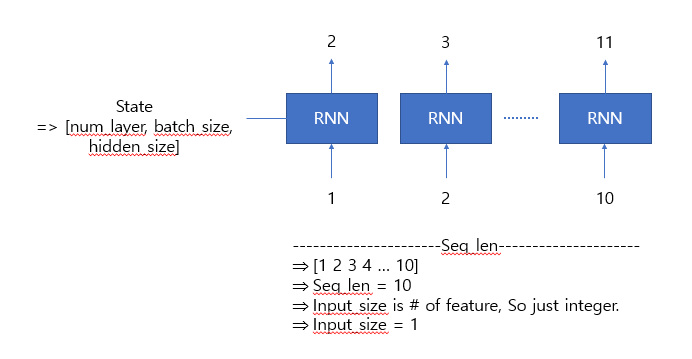I’m studying RNN and pytorch.
I just want to predict integer sequence.
This picture shows what i want to do and my idea.
please help me.
I think my concept is wrong.
I want to fix it.
class myRNN(nn.Module):
def __init__(self, input_size, hidden_size, num_layer):
super(myRNN, self).__init__()
self.input_size = input_size
self.hidden_size = hidden_size
self.num_layer = num_layer
self.rnn1 = nn.RNN(input_size, hidden_size, num_layer)
#input_size, hidden_size, num_layer
#hidden_size 는 한 layer내의 block size
def forward(self, input, hidden):
output, hidden = self.rnn1(input, hidden)
return output, hidden
def init_hidden(self):
hidden = Variable(torch.zeros(num_layer, batch_size, hidden_size))
return hidden
if __name__ == '__main__':
seq_len = 10
input_size = 1
hidden_size = 10
num_layer = 1
batch_size = 1
#
rnn = myRNN(input_size, hidden_size, num_layer)
#loss, optimizer
optimizer = torch.optim.Adam(rnn.parameters(), lr = 0.0001)
example = [1,2,3,4,5,6,7,8,9,10,11]
input_data = Variable(torch.FloatTensor(example[:-1]).view(seq_len, batch_size, input_size))
label = Variable(torch.FloatTensor(example[1:]).view(seq_len, batch_size, input_size))
print(input_data.size(), label.size())
hidden = rnn.init_hidden()
print(hidden.size())
hidden = rnn.init_hidden()
loss = 0
optimizer.zero_grad()
output, hidden = rnn(input_data, hidden)
print('output / label' , output.size(), label.size())
loss = nn.functional.nll_loss(output, label)
loss.backward()
optimizer.step()
print(loss)
(** PS **) After I implement the RNN with another code(not the above code), i got a output with float not integer.
-0.9967 -0.4590 0.9998 -0.9367 0.5538 -1.0000 1.0000 -1.0000 1.0000

